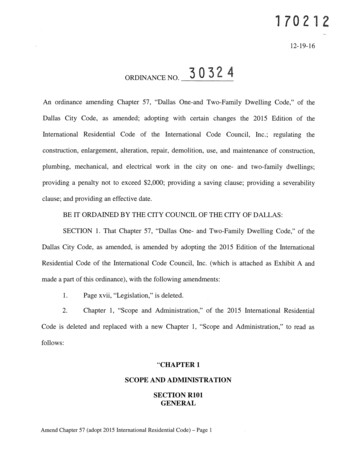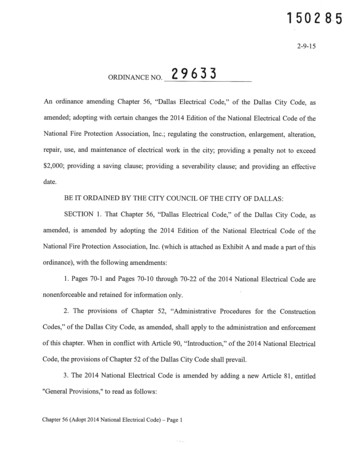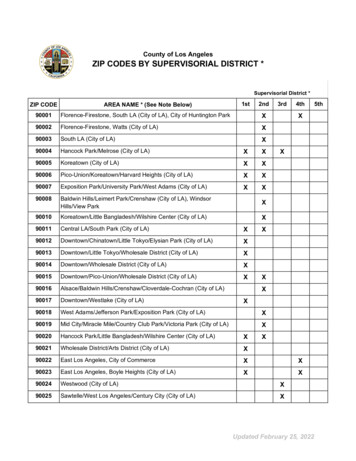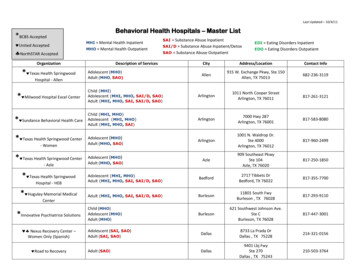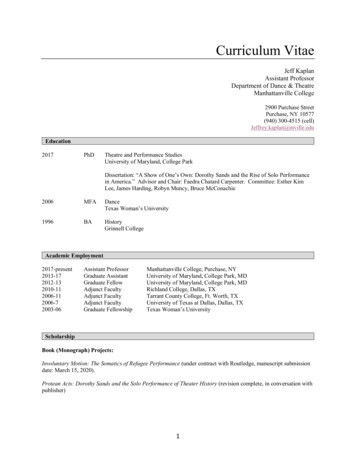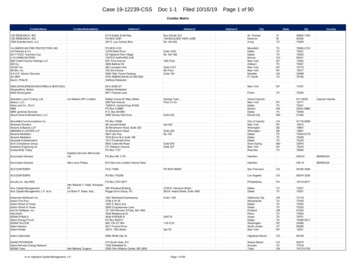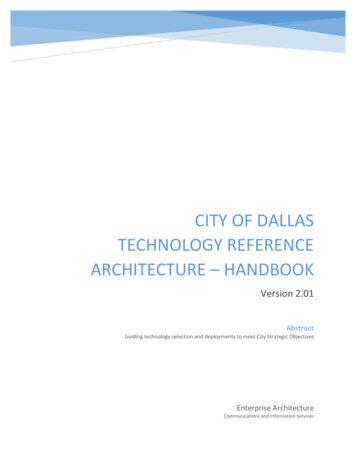
Transcription
CITY OF DALLASTECHNOLOGY REFERENCEARCHITECTURE – HANDBOOKVersion 2.01AbstractGuiding technology selection and deployments to meet City Strategic ObjectivesEnterprise ArchitectureCommunications and Information Services
Attribution Notice:This document draws heavily upon the document set noted in the references section of this document.The DoD Reference Architecture Description provided a large foundation for this document. The CloudSecurity Alliance (CSA) reference architecture documentation also provides a large amount of guidanceand foundational material to the City Enterprise Reference Architecture described in this document.Contact InformationChief Technology ArchitectDepartment of Communications and Information ServicesCity Hall, ity of DallasEnterprise ArchitecturePage i
Table of Contents1 Introduction . 1Purpose . 1How to Use This Document . 1Document Structure . 1Background . 2Approach . 3City and CIS Strategic Plan Guidance to Reference Architecture Development . 3Attribution. 32 Reference Architecture Definition . 53 City of Dallas Technology Reference Architecture . 7Strategic Purpose . 8Principles . 8Technical Positions . 9Patterns . 9Vocabulary . 94 City of Dallas Technology Reference Architecture Description . 10Data Management Services . 10Structured Data . 11Unstructured Data . 11Data Governance . 11Business Application Services . 13Presentation Services . 13Presentation Platforms . 13Application Services . 14Infrastructure Services . 15Network Services . 15On-Prem/Co-Location Infrastructure . 16Cloud Infrastructure . 16Security Management Services . 17Identify . 19Protect. 19Detect . 19City of DallasEnterprise ArchitecturePage ii
Respond . 20Recover . 20IT Service Management . 21Service Strategy. 23Service Design . 23Service Transition . 23Service Operation and Support . 24Program Management . 25IT Governance . 27Enterprise Architecture (EA) . 27Project Management Office (PMO) . 275 Summary . 28Appendix A: Solution Reference Architecture Sample Outline. 29Appendix B: Examples of Solution Reference Architectures . 30OASIS SOA Reference Architecture . 30The Open Group SOA Reference Architecture . 30Appendix C: References . 32Appendix D: Definitions . 35Architecture Definitions . 35Solution Architecture . 35Reference Architecture . 35Cloud Computing Definitions . 35On-demand self-service. . 35Broad network access. . 35Resource pooling. . 35Rapid elasticity. . 35Measured service. . 35City of DallasEnterprise ArchitecturePage iii
1 IntroductionThe term Reference Architecture, within the Information Technology community, has various meanings,multiple purposes and uses, varying levels of detail and abstraction, and very little common guidance.The Chief Technology Architect for Innovation and Information Management (IIM) within theDepartment of Communication and Information Services (CIS) for the City of Dallas requested a positionon – and strategy for – Reference Architecture use in the department. This Reference Architecturehandbook is the response to the Chief Architect’s request.PurposeThe objective is to provide useful guidance and direction on the development and use of ReferenceArchitecture as a tool to guide and constrain architecture and solution development. This documentprovides guidance for the development and use of Reference Architecture in the form of a Citydefinition for Reference Architecture and a description for City‐wide Reference Architecture. Thedefinition is applicable to all City Reference Architectures, while the description focuses on a unique setof City Reference Architectures that provide guidance to the department (CIS), hereafter referred to asCity‐wide Reference Architectures. This description establishes standard criteria for City‐wide ReferenceArchitectures.How to Use This DocumentIndividuals and organizations looking to implement solutions for the City of Dallas are expected to useand comply with the City’s approach to Reference Architecture as outlined in this document, the currentversion of the City’s Technical Reference Architecture (TRA) Version 3.01, and the Technical ReferenceArchitecture Checklist Version 3.01. These guiding documents should be used by vendors duringcreation of a Solution Reference Architecture. The goal of a Solution Reference Architecture is toidentify and describe compliance with the City Enterprise Reference Architecture, competently andcompletely describe the architecture of a solution, and to communicate solution value relative to theguiding principles outlined in Section Three of this document.Vendors should be prepared to: Align Solution Reference Architectures with the approach defined by the City of Dallas,utilize the language defined by the City’s TRA definition and description where applicable,comply with the common standards, specifications, and patterns as defined by the City’s TRA,and be prepared to validate the proposed solution against the City’s Reference Architecture.Document StructureThis document is structured to provide a logical progression of information about ReferenceArchitecture at the City. It consists of five sections and a set of appendices. Section 1: Provides an introduction that describes the purpose, background, approach, andstructure for this document. Section 2: Provides the City definition for Reference Architecture.
Section 3: Provides a description for the City‐wide Reference Architecture. This section describesand discusses the five elements of a City‐wide Reference Architecture. Section 4: Provides a sample of City Architecture Framework views and models that could beused in describing the five Reference Architecture elements. Section 5: Provides a summary of the key points and positions described in this document. Appendices A‐D: Appendix A provides a sample Reference Architecture outline for SolutionArchitecture based upon the City Enterprise Reference Architecture. Appendix B providesexamples of existing Reference Architectures. Appendix C provides a list of references in thisdocument. Appendix D provides pertinent definitions for use with the Technology ReferenceArchitecture.BackgroundReference Architectures have been used in Industry to provide information, guidance, and direction forfocused subject areas. These Reference Architectures have wide‐ranging purposes, uses, levels of detail,and levels of abstraction. The term itself has multiple definitions and meanings and seems to be relativeto the context of the environment in which it is used. A Google search for Reference Architecturereturned more than 523,000 results. [DoD Reference Architecture]Reference Architecture literature can be found throughout Industry addressing various subject areas.Due to current interests in Service Oriented Architecture (SOA), a good amount of existing ReferenceArchitecture literature is focused on this area. Most notable are the efforts by the Organization for theAdvancement of Structured Information Standards (OASIS), The Open Group Architecture Forum(TOGAF), and the Object Management Group (OMG). [DoD Reference Architecture]As information, services, and infrastructure requirements and solutions continue to evolve, the need forReference Architecture increases. Reference Architecture serves as a tool for providing commoninformation, guidance, and direction to guide and constrain architecture and solutions. A City definitionis needed to establish this broader perspective of Reference Architecture as the common position acrossthe City. While Reference Architectures with varying purposes, uses, and content could exist at manylevels throughout the City, a standard set of criteria needs to be established for City‐wide ReferenceArchitecture. A standard set of criteria for City‐wide Reference Architecture enables consistentdevelopment, use and assessment of these architectures. It also establishes a common City expectationof the content provided by a City‐wide Reference Architecture. This document focuses on describing thestandard criteria. [DoD Reference Architecture]To support Reference Architecture efforts at the City, Enterprise Architecture has adopted the CloudSecurity Alliance (CSA) Reference Architecture as a baseline – or foundation – for constructing andcommunicating Reference Architecture (both Enterprise-level and Solution-level). The CSA ReferenceArchitecture has strengths that other offerings do not. Though Service Oriented Architectures (SOA) area common way to communicate, reference architectures based upon SOA are generally softwarefocused and fail to account for data and information, infrastructure and various operational aspectsneeded in a reference architecture. As the CSA Reference Architecture attempts to describe andcommunicate additional layers of architecture not noted in SOA architectures and models, it wasdecided that the CSA Reference Architecture provided the City with the opportunity to communicateCity of DallasEnterprise ArchitecturePage 2
needs and desires more completely that a SOA-only reference architecture. Hence, the CSA ReferenceArchitecture description may be referenced as collateral material when inspecting the City EnterpriseReference Architecture. [DoD Reference Architecture]ApproachThe approach for developing this document involved three steps:a. The first step was to research and gather existing Reference Architecture documents andinformation from commercial and government sectors. The intent is to pull together thebroadest, representative sample of Reference Architecture materiel as possible.b. The second step was to examine and analyze the Reference Architecture material to betterunderstand existing concepts of Reference Architecture, what it is used for, its goals, objectives,characteristics, and key elements. The intent was to discover common threads for defining bestpractices for developing Reference Architectures.c. The third step was to develop a City definition for Reference Architecture and a description forCity‐wide Reference Architecture based on the analysis of Reference Architecture material andthe intent of the Chief Technology Architect.City and CIS Strategic Plan Guidance to Reference Architecture DevelopmentThe reference architecture presented in this document facilitates the achievement of City of Dallas goalsrelative to technology usage.The City Strategic Goals are:1.2.3.4.5.6.Public SafetyMobility Solutions, Infrastructure and SustainabilityEconomic and Neighborhood VitalityHuman and Social NeedsQuality of LifeGovernment Performance and Financial ManagementThe Key Goals identified in the City’s Technology Strategic Plan are:1.2.3.4.Citizen-CentricData-CentricSmart CitySecurity and PrivacyAttributionEnterprise Architecture (EA) and its supporting reference architectures are heavily dependent uponperspective. In the case of the reference architecture described in this document, guidance towards aCloud First strategy is provided. This guidance is developed from current understandings of major cloudreference architectures – that provided by the Cloud Security Alliance (CSA). The guidance in thishandbook also draws heavily upon process-oriented reference architectures provided by Industry andgovernment. The goal here is to provide this document’s audience with an understanding that foresightCity of DallasEnterprise ArchitecturePage 3
benefits the selection, implementation, deployment, operation, maintenance, management and finaldecommissioning of any solution.This document draws heavily upon the document set noted in the references section of this document.The DoD Reference Architecture Description provided a large foundation for this document. The CloudSecurity Alliance (CSA) reference architecture documentation also provides a large amount of guidanceand foundational material to the City Enterprise Reference Architecture described in this document.City of DallasEnterprise ArchitecturePage 4
2 Reference Architecture DefinitionAn examination and analysis of numerous existing Reference Architecture definitions within Industryrevealed common points among them. A common theme among the definitions is that the primarypurpose of a Reference Architecture is to guide and constrain the instantiations of solution architecturesas depicted in Figure 2. Based on this, a Reference Architecture is considered an organizational asset in: Providing common language for the various stakeholdersProviding consistency of implementation of technology to solve problemsSupporting the validation of solutions against proven Reference ArchitectureEncouraging adherence to common standards, specifications, and patternsFigure 1 Reference Architecture Purpose / DoD Reference ArchitectureOther relevant terms used in the definitions include “patterns” and “solution architectures”. Patternsare models of architecture representations at a level of generality that provides some degree of reuse.The City Architecture Framework defines Solution Architecture as a framework or structure thatportrays the relationships among all the elements of something that answers a problem. It describes thefundamental organization of a system, embodied in its components, their relationships with each otherand the environment, and the principles governing its design and evolution. Solution architectureinstantiations are guided and constrained by all or part of a Reference Architecture where thegeneralized and logical abstract elements of the Reference Architecture are replaced by real world,physical elements according to the specified rules, principles, standards and specifications. [DoDReference Architecture]From all of this, a derived Citywide definition for Reference Architecture is [DoD ReferenceArchitecture]:Reference Architecture is an authoritative source of information about a specificsubject area that guides and constrains the instantiations of multiplearchitectures and solutions. [DoD Reference Architecture]Reference Architecture serve as a reference foundation for architectures and solutions and may also beused for comparison and alignment purposes. There may be multiple Reference Architectures within aCity of DallasEnterprise ArchitecturePage 5
subject area where each represents a different emphasis or viewpoint of that area as depicted in Figure3. For each Reference Architecture, there may be any number of architectures and solutionscorresponding to different aspects of the subject area viewpoint. [DoD Reference Architecture]Figure 2 Reference Architecture Relationships / DoD Reference ArchitectureReference Architectures may be defined at many levels of detail and abstraction (from specific togeneralized) and for many different purposes. In fact, a Reference Architecture for one subject area canbe a specialization of a more general Reference Architecture in another subject area. The level ofabstraction provided in a Reference Architecture is a function of its intended usage. Where solutionarchitectures are to be developed based on a specific Reference Architecture, the level of detailprovided as a reference may have to be greater than if a Reference Architecture is intended to be usedfor alignment purposes only. [DoD Reference Architecture]Reference architectures may also be complimentary in guiding architectures and solutions. Figure 3 alsoshows that Reference Architecture may guide and constrain various types and instantiations ofarchitecture depending on the purpose and scope. City‐wide Reference Architecture, due to its broaderpurpose and scope, may guide and constrain Enterprise, Segment, Capability, and SolutionArchitectures. [DoD Reference Architecture]City of DallasEnterprise ArchitecturePage 6
3 City of Dallas Technology Reference ArchitectureThe City of Dallas Technology Reference Architecture is part of the City Enterprise Architecture (EA).Figure 4, City of Dallas Technology Reference Architecture, shows the construct of the TechnologyReference Architecture depicting its components and their general relationships.Figure 3 City of Dallas Technology Reference ArchitectureThe Technology Reference Architecture provides information, guidance, and direction that is applicableacross the City. This information, guidance, and direction are provided in the five (5) elements thatcomprise a Citywide Reference Architecture. [DoD Reference Architecture]a. Strategic Purpose – Identifies goals and objectives of the Reference Architecture and describesthe specific purpose of and the problem(s) to be addressed by the Reference Architecture. [DoDReference Architecture]b. Principles – Sufficient high-level foundational statements of rules, culture, and values that drivetechnical positions and patterns. [DoD Reference Architecture]c. Technical Positions– Technical guidance and standards, based on specified principles that needto be followed and implemented as part of the solution. [DoD Reference Architecture]d. Patterns (Templates) – Generalized architecture representations (viewpoints, graphical/textualmodels, diagrams, etc.) that show relationships between elements and artifacts specified by thetechnical positions. [DoD Reference Architecture]City of DallasEnterprise ArchitecturePage 7
e. Vocabulary – Acronyms, terms, and definitions that are used in the Reference Architecture andrelevant to architectures and solutions that are guided and constrained by the ReferenceArchitecture. [DoD Reference Architecture]Strategic PurposeThe strategic purpose describes the context for the Reference Architecture and provides the basis forthe principles, technical positions, patterns, and vocabulary in the Reference Architecture. The contextincludes descriptions of the scope, goals, and purpose of the Reference Architecture, why it is needed,and when and how it should be used. The key authoritative sources used in the development of theReference Architecture, as well as the intended audience (to whom the architecture is directed), shouldalso be included in this section. The strategic purpose should explicitly identify the primary producingstakeholder (owner) organizations that will develop and implement related architectures and solutions.It should also explicitly describe the issue(s) and stakeholder concern(s) that will be addressed by theReference Architecture. Understanding and consensus on the strategic purpose of the ReferenceArchitecture will enable end‐to‐end traceability between organizational context and an eventualsolution implementation. [DoD Reference Architecture]The Strategic Purpose for the City of Dallas’ Technology Reference Architecture is to facilitate theachievement of City of Dallas goals relative to technology usage as described previously in City and CISStrategic Plan Guidance to Reference Architecture Development. The Technology ReferenceArchitecture is intended for use both by City departments and vendors when creating SolutionReference Architecture. The Technology Reference Architecture should be used for all Technologyacquisition, upgrade, and evolution activities conducted with the City of Dallas.PrinciplesPrinciples are high‐level statements that apply to the subject area and tie back to businessrequirements. They incorporate values and organizational culture and drive technical positions andpatterns in defining how an organization fulfills its mission. The identification of assumptions andconstraints can assist in gaining an understanding of the context of the Reference Architecture, whichcan provide a helpful perspective on the guiding principles. [DoD Reference Architecture]Principles are general rules and guidelines that should be understandable, robust, complete,independent, and are not intended to state the obvious. They inform and support the way in which anorganization sets about fulfilling its mission and are intended to be enduring and seldom amended. Inthe Citywide Reference Architectures (either Enterprise or Solution), principles without any additionalinformation should be enough to clearly convey the general intent of the Reference Architecture. Insome cases, principles may be extracted from relevant subject area policy. In other cases, they may becreated because of the development and analysis of the Reference Architecture. [DoD ReferenceArchitecture] The following are principles supporting the City’s Reference Architecture: Appropriate Business Value must be presentFocus on Desired Business OutcomesCitywide ScopeStandards BasedSimpleScalableCity of DallasEnterprise ArchitecturePage 8
StrategicReliableSustainableSecureService OrientedCloud DrivenTechnical PositionsTechnical positions describe the technical guidance and standards established for a subject area. Due torapidly evolving technology, technical positions are likely to change often to keep up with industry.Required services, standards, agreements, security model, communication protocols, web services, XMLnamespaces, data quality, etc. are all technical positions that must be described and addressed in aCitywide or Solution Reference Architecture. [DoD Reference Architecture]Defining technical positions forces an organization to identify relevant technical guidance and standardsand justify their choices and tradeoffs. For example, a SOA Reference Architecture would includedescriptions of the services and standards to assist architects in understanding and incorporating themin solution architectures for the subject area. [DoD Reference Architecture]An effective way for conveying technical positions is via a table that contains information relevant to astandard, but technical positions may be described in various ways. [DoD Reference Architecture]PatternsPatterns show how artifacts may be organized and related for repeated use. They are typically low tomid-level tabular, structural, behavioral, or graphical model abstractions that focus on interaction of theartifacts. Patterns undergo change most often as new pattern concepts are discovered and emerge fromsolution architectures. [DoD Reference Architecture]Patterns may be conveyed through various means such as Activity Models, Process Models, andBehavioral Models. It is important to identify the pattern and describe it with enough detail for it to beclearly understood and used appropriately. [DoD Reference Architecture]Three potential benefits of architecture patterns are: 1) they enable improved communication betweenstakeholders; 2) they facilitate application of sound architectural concepts and implementations; and 3)they can become standardized through multiple implementations. An effective way to develop afoundation to provide patterns of operational behavior is to leverage the activities of an Activity NodeTree with an Activity Event sequence diagram. This combination of viewpoints exploits the relationshipbetween the process model and the operational activities, while supporting the c
on - and strategy for - Reference Architecture use in the department. This Reference Architecture handbook is the response to the hief Architects request. . Enterprise Architecture (EA) and its supporting reference architectures are heavily dependent upon perspective. In the case of the reference architecture described in this document .

